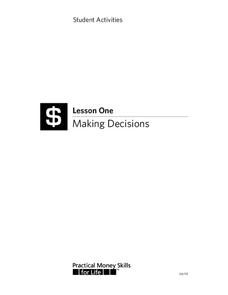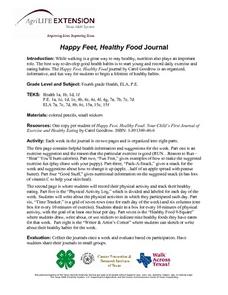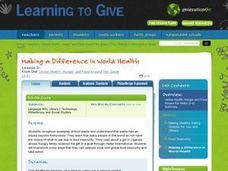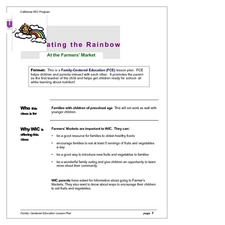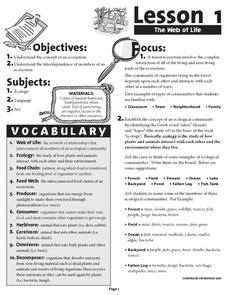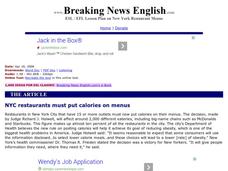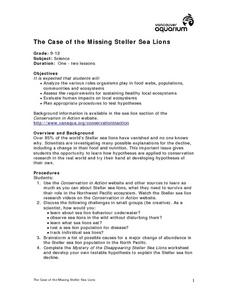Visa
Making Decisions
What economic factors can influence personal and financial decisions? In an effort to understand opportunity costs and the time value of money, pupils engage in role-playing activities and discussion, as well as view a PowerPoint...
Baylor College
Digestion
Digestion is an amazing and complicated process that provides humans with the energy they need to survive. Lesson six in this series on the science of food uses sliced turkey and a meat tenderizer to demonstrate how enzymes help break...
Curated OER
Happy Feet, Healthy Food Journal
Fourth graders record their physical activities and eating habits in a journal. They place their answers in the workbook, Happy Feet, Healthy Food. They sketch and write about their weekly healthy habits.
Curated OER
Transforming Food Energy: A Balancing Act
Pupils explain their role as consumers. They use a purchased calorimeter or make their own simple calorimeter to measure the energy content in selected foods. This interesting lesson really gets students thinking about what they eat.
Curated OER
Water/Hydration
Students develop an understanding of the role water has in the body and the importance of getting enough water each day. Through the lesson, students recognize the risks and signs of dehydration. Also, they identify foods with high...
Curated OER
Dietary Guidelines 2000
Students research dietary guidelines and create a Microsoft Powerpoint presentation that reviews the dietary guidelines to present to their class or an elementary class.
Curated OER
Factors Affecting Plant Growth
High schoolers determine the physical and chemical factors that affect plant growth. For this biology lesson, students explain the role of hormones in plants. They investigate how competition with other plants affect their growth.
Curated OER
Making a Difference in World Health
Students discover environmental awareness by conducting a collection project in class. In this global food lesson, students identify the importance of feeding all of the humans on Earth and discuss why some aren't properly nourished....
Curated OER
Fats: A Type of Lipid
In this nutrition worksheet, students complete a graphic organizer about the function of fats in the diet. They compare unsaturated and saturated fats. They tell what happens when one has either too much or too little fats, and record...
Curated OER
Food Poems and Base Words
Students identify base words to decipher new vocabulary. In this vocabulary instructional activity, students complete a graphic organizer while reading about food and nutrition. Students discuss simple and complex endings when using...
Curated OER
Eating the Rainbow: At the Farmer's Market
Students share what type of fruit and vegetables they like. In this adult health instructional activity, students explain the benefits of eating healthy foods. They discuss recipe ideas that can be done at home.
Curated OER
Life Process of Living Things
In this life processes worksheet, students complete a graphic organizer by filling in the 7 life processes of living things: move, grow, reproduce, senses, nutrition, excrete, and respire.
Curated OER
Goobers. Goobers? Goobers!
Students begin the lesson by noting the many ways in which to use peanuts. In groups, they use the internet to research the work of George Washington Carver. They discover the allergies and nutritional information of the peanut and...
Curated OER
The Web of Life
Students participate in a game in which they discover the balance of life in the ocean. They identify different organisms that rely on different types of food. They answer questions to complete the lesson.
Curated OER
Breaking News English: NYC Restaurants Must Put Calories on Menus
In this English worksheet, students read "NYC Restaurants Must Put Calories on Menus," and then respond to 1 graphic organizer, 47 fill in the blank, 7 short answer, 20 matching, and 8 true or false questions about...
Curated OER
The Case of the Missing Steller Sea Lions
Students identify and analyze the various roles organisms play in food webs, populations, communities and ecosystems. Students assess the requirements for sustaining healthy local ecosystems. STudents evaluate human impacts on local...
Curated OER
Coping With War: Diversions in a Century of Global Conflict
Eleventh graders analyze photographs representing leisure and transition during a global conflict. Working in groups, 11th graders review pictures from a web exhibit. The group completes a graphic organizer analyzing the photograph for...
Curated OER
Hardy Heart: Kit Instructions
Students describe human anatomy by reading a children's book. In this heart health lesson, students examine illustrations of heart images and several organ related children's stories. Students discuss ways to keep a healthy heart and...
Curated OER
Lesson: Peaches
Students explore the benefits of eating fruits and vegetables. They discover how to choose and store peaches and use recipes to prepare peaches. They explore the history of peaches and discuss the benefits of eating peaches.
Curated OER
Coral Reefs Endangered
Learners research where in the world coral reefs are located. In this ecology lesson, students create food chains and food web. They simulate growing coral reefs to understand their characteristics better.
Curated OER
Nutritionist for Hire
Tenth graders role play that they are nutritionists devising a healthy dietary plan that focuses on the client's needs.
Curated OER
Good Enough To Eat
Young scholars are introduced to the five food groups. In groups, they place different foods into the correct section of the Food Pyramid. Using different types of technology, they create one page of a class ABC book sharing what they...
Curated OER
Foods for Better Health
Students define biotechnology and discuss the economic impact of biotechnology. They also describe what a 1015 onion and a slow-softening tomato are and how they are produced. They examine the safety of genetically-engineered or altered...
Curated OER
Vegetable Lab
Third graders prepare vegetables using common methods: au gratin, minimum water method, broiled, panfry, frozen, and stuffed. They share with the rest of the class and determine which methods preserve nutrients, color, flavor and texture.
